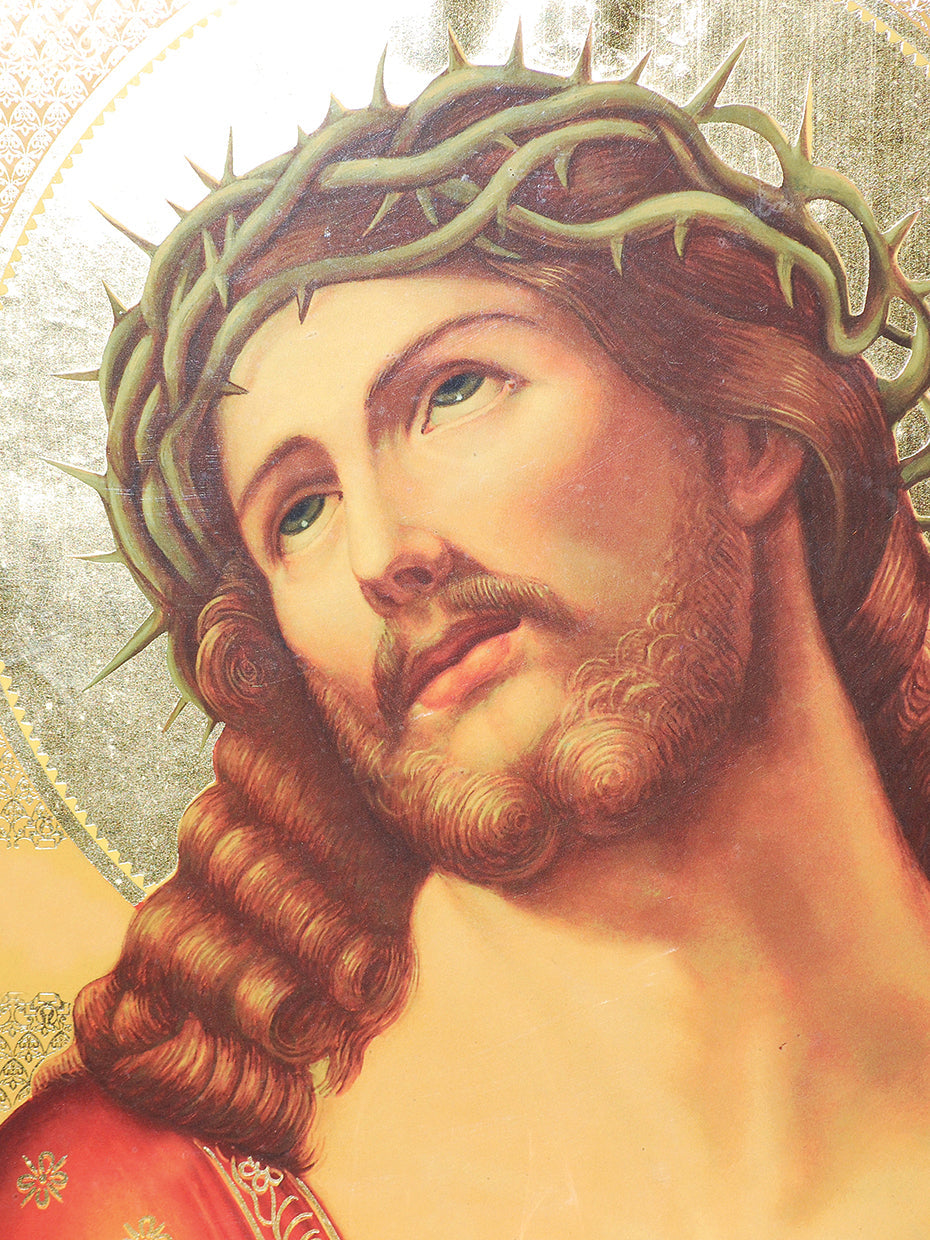
HOW TO USE ART TO REPRESENT DEATH AND SALVATION DURING EASTER
Even though everyone loves Christmas cookies and jolly old St. Nick, Easter has been considered the most sacred day in the Christian calendar for centuries. Artwork exploring the Passion and Resurrection of Jesus Christ transcend the Easter season, providing an experience of mystery and majesty year-round.
Much of the power of the Easter miracle lies in the humility and simplicity of its telling. Christ was ridiculed by jeering Roman soldiers as he walked what is now called the Via Dolorosa, the Way of Sorrows, struggling under the weight of the massive cross upon which he would soon be crucified. As a cruel joke, the Romans crowned him with thorns, then taunted and mocked him as "King of the Jews"—a sarcastic title which both Jesus and the San Hedrin, the Rabbinic court of Jerusalem, rejected.
After suffering on the cross, the body of Jesus was lowered, bathed, and dressed in clean linen before being placed in the tomb. The following day, the faithful sought out the Savior, but the rock sealing the tomb's entrance had been rolled away, and it was empty.
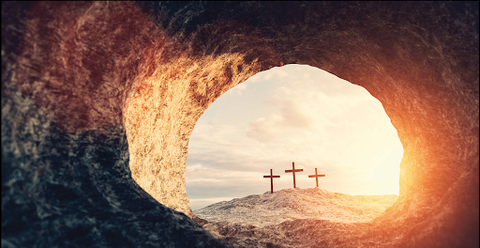 Religion Cave Cross II by Michal Bednarek
Religion Cave Cross II by Michal Bednarek
In this stunning image, we see Golgotha, the hillside where Jesus was executed alongside two common thieves, as the sun rises on the day of Christ's Resurrection. The view from inside the tomb is as Christ himself would have seen the site of his death, offering an inspiring vision of hope for all who suffer in this worldly life.
The nature and character of Christian sacred art has changed and evolved over the centuries. For many generations, literal, naturalistic portrayals of Christ on the cross were the standard.

In some traditions, including the Eastern Orthodox church, depictions of Christ and the saints were more than symbolic. The images were believed to possess supernatural powers which could be spoken to directly for revelation, intervention, and bodily healing.
Long before the Scripture was translated from Aramaic and Greek into Latin common languages, much of the world's population could neither read nor write. This fact contributed to the need for visual depictions of the Christian story, including the Stations of the Cross, which were common in Catholic churches until the mid-20th century. The violence, sorrow, and splendor of Christ's redemption were conveyed with illustrations, explained in local idioms by the parish priest.
Paintings of this genre emphasize the horror of Christ's bodily mortification. The word commonly used to describe Christ on the cross is "The Passion." To our modern ears, "passion" may suggest earthly, erotic pleasures and one's life's ambitions, as in "He has a passion for Italian sports cars." But in fact, the word "passion" really means suffering, derived from the Greek root word "pathos." We see this root in the word "compassion," meaning to suffer with another. "Sympathy" and "empathy" arise from the same linguistic source.
In this depiction, we feel Christ's dying body's tremendous, wrenching weight as he sags forward from where his hands have been viciously impaled, reminding us of his full humanity and willingness to suffer and die to redeem the sins of humanity. The three Marys, including his mother, weep at his feet while a smug Roman centurion in full battle dress looks on. Another Roman soldier in the background regards the spectacle with less bravado and a questioning, searching look. Even more telling, two Rabbinic figures in traditional Jewish garments look away in despair, unable to intervene in what is clearly an unjust and inhumane act.
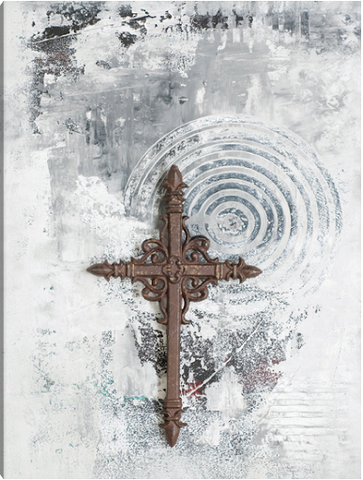 Snowy Silver Cross Canvas by DP Gallery
Snowy Silver Cross Canvas by DP Gallery
Today, many people find these graphic depictions of suffering too intense for daily consumption, preferring a meditative abstract. The cruciform itself is a powerful and sanctified icon of faith for many modern Christians.For instance, an ornate bronze cross with a heavy patina superimposed on a graphic background suggests the endurance of faith in our secularized times. The distressed, industrial-gray background creates a gritty, contemporary context for the antiquity of the crucifix. A concentric circular motif draws focus to the eternity of belief symbolized by the baroque cross, reinforcing the relevancy of the Christian message in modern times.
Beginning in Lent, extending through Ash Wednesday, Good Friday, and Maundy Saturday, the day before Easter, Christendom drapes itself in the black and purple clothing of mourning. The faithful fast from rich foods and all luxuries and devote themselves to 40 days of deep meditation and penance, honoring the 40 days that Jesus fasted in the wild and defied Satan in the desert.
This encounter produced one of the New Testament's most memorable passages. Satan asks Jesus if he's hungry; after all, it's been weeks since the Last Supper! This simple question reinforces the humanity and humility that defined the Messiah. Taunting Jesus further, Satan commands that, since he must be hungry, Jesus should turn a stone into a piece of bread to ease his growling belly. Christ's reply: "Man does not live by bread alone."
The darkness of the church during the weeks leading up to Easter echoes the deep despair Christ experienced in the garden of Gethsemane when Jesus knew that Roman thugs would come for him before daybreak to scourge him and lead him to his death. His well-meaning Apostles fell asleep in the comforting darkness of the garden, a metaphor for how easily we as humans slip back into our unconscious, sinful ways. In traditional Catholic, Episcopalian and Orthodox practice, the High Altar is draped wth black vestments during Holy Week. Each candle in the church is extinguished one by one, symbolizing Christ's grief as he cried, "Father, why hast Thou forsaken me?"
The imagery of darkness and light permeates the New Testament. The joy of Easter morning and the miracle of the Resurrection is captured in this Large Abstract Wall Art, where the pure, white light of salvation blazes above all of the noise, chaos, and confusion of human life. On Easter morning, black cloth is stripped from the church, the candles are lit, and bouquets adorn the altar, rejoicing at the end of winter and the return of spring, more light, and longer days when flowers appear on the earth. Gleaming gold and white draperies replace the darkness, and the congregation exults, "He has Risen!"
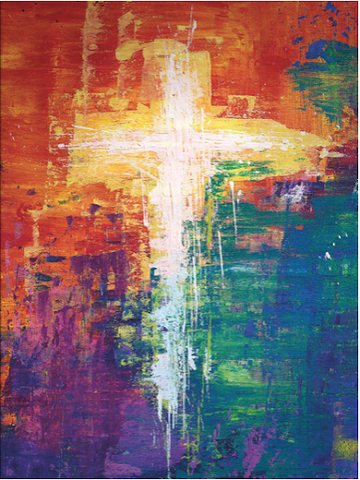 Sunset Spiritual White Cross by DP Gallery
Sunset Spiritual White Cross by DP Gallery Religious iconography reaches into the depths of our being through the use of archetypes. Carl Jung first defined archetypes a century or so ago as symbols in the collective human unconscious. Jung maintained that archetypes are innately present in the human psyche. As humans, we remember and reinforce the power of archetypes through systems and conventions that we create for ourselves. The archetypes are already fully formed inside our minds, and our human consciousness and expression reveal them.
The notion of flight and ascension is one of the most widely known archetypes, appearing in the early cave paintings and petroglyphs. Think of proper, stuffy, starchy Mary Poppins, who flew using her umbrella, old St. Nick and his airborne reindeer, the defiant Peter Pan, and the Wicked Witch of the West are just a few familiar examples of this. Their ability to fly directly links them to the wizards, shamans, and gods.
Because the imagery of Christianity arises from the collective unconscious, wings, flight, and ascension hold tremendous power in Christian belief. While the Biblical descriptions of angels identify cherubim and seraphim as having six wings, Western Christian art typically portrays only two bird-like wings, which symbolize the Holy Spirit who descended upon the faithful like a mighty wind at Pentecost. The descending dove represents the presence of the Holy Spirit as the unseen force by which humans receive God's grace.
A modern-Gothic depiction of an intricate cross, supported by the wings of a snow-white dove—an image recounted in many American country-western and bluegrass songs and traditional hymns – expresses the triumph of faith over sin and eternal life over death.
 Cross I Canvas Print by Brandon Glover
Cross I Canvas Print by Brandon Glover Part of what makes the Christian story, specifically the chain of events leading up to Holy Week, so compelling is the richness of the storytelling. While the ultimate message is hope and redemption, the depths of despair that Jesus experienced in Gethsemane, abandoned by those he loved, and betrayed by the kiss of Judas Iscariot, give the story its heartbreaking, relatable humanness.
We struggle to reconcile these elements, seeking a symbolic resolution. This striking piece of modern sacred art does just that by juxtaposing highly charged symbolic elements into a dramatic yet comforting composition.
Whether choosing a piece of Large Abstract Wall Art for a modern setting, or a more representational artwork for a traditional home, images of Easter’s parable of death and rebirth are inspiring and timeless.
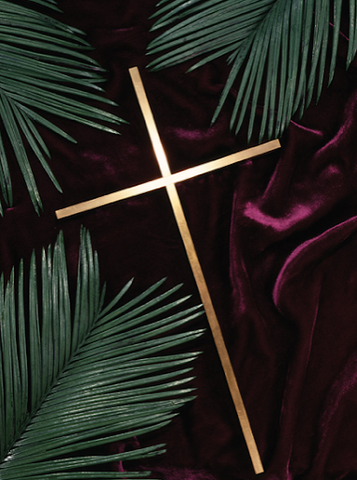 Gold Cross Palm Fronds Canvas by Vintage Images
Gold Cross Palm Fronds Canvas by Vintage ImagesThis Gold Cross Palm Fronds Canvas Print brings together three powerfully iconic design components to tell the story of Christ's triumph: the purple velvet of royal mourning, the irony of the palm fronds used for Palm Sunday, and the enduring preciousness of the golden cross.
Purple was associated with royalty and nobility in the ancient world because of the tremendous cost of obtaining purple dye. The only stable purple dye available was extracted from a species of mollusk called the Murex. The dye was so expensive that only emperors and their nobles were permitted to wear purple garments. In the Christian world, purple is the color of mourning since the Romans mockingly called Christ the King of the Jews, a title he rejected.
The palm fronds in this depiction have a potentially ironic meaning, suggesting the fickleness of human affections. When Jesus enters Jerusalem on the day Christians now call Palm Sunday, the adoring crowds call him Savior and strew his path with palm branches, a gesture of respect and reverence. A few days later, the masses have turned into an angry mob, bellowing, "Crucify him!" The response of Jesus is heartbreakingly compassionate: "Forgive them, Father, for they know not what they do."
Velvet fades, disintegrates, and returns to dust. The same goes for palm fronds, although Christianity dignifies these blessed leaves by burning them to create the cinders that cross the faithful's foreheads on Ash Wednesday.
What persists is the cross, made from gold which never rusts or degrades. Placed there amidst reminders of mockery, betrayal, scorn, the cross survives, a symbolic counterpart to the burning bush of the Old Testament.
These Christian images take on an exceptionally sharp poignancy during the Eastertide season when Christ's humanity and sacrifice are keenly felt by all. But these expressions of faith can serve as a moving focal point in your home or place of business year-round, reminding all who see them that Christ's love transcends all suffering, transforming pain into paradise.
 Celebrities
Celebrities
 Contemporary
Contemporary
 Fashion
Fashion
 Sports
Sports
 Father's Day
Father's Day
 Halloween
Halloween
 Mother's Day
Mother's Day
 Spring
Spring
 Summer
Summer
 Thanksgiving
Thanksgiving
 Farm Animals
Farm Animals
 Architecture
Architecture
 Barns & Farms
Barns & Farms
 Botanical
Botanical
 Places
Places
 Boho Mid-Century
Boho Mid-Century
 Modern
Modern
 Figurative
Figurative
 Grand Millennial
Grand Millennial
 Reimagined Masterpieces
Reimagined Masterpieces
 Typography
Typography
 Impressionism
Impressionism
 Black
Black
 Blue
Blue
 Green
Green
 Orange
Orange
 Pink
Pink
 Red
Red
 Teal
Teal
 Yellow
Yellow
 Bronze
Bronze
 Burgundy
Burgundy
 Copper
Copper
 Neutrals
Neutrals
 Black & White
Black & White
 Colorful
Colorful
 Gold & Silver
Gold & Silver
 Tan & Beige
Tan & Beige
 Very Peri
Very Peri
 Georges Seurat
Georges Seurat
 Oliver Jeffries
Oliver Jeffries
 Synthia Saint James
Synthia Saint James
 Tom Quartermaine
Tom Quartermaine
 Dean Russo
Dean Russo
 Farida Zaman
Farida Zaman
 Jane Slivka
Jane Slivka
 Mark Chandon
Mark Chandon
 Nan
Nan
 Sylvie Demers
Sylvie Demers
 Georgia O'Keeffe
Georgia O'Keeffe
 Gustav Klimt
Gustav Klimt
 Leonardo da Vinci
Leonardo da Vinci
 Pierre-Auguste Renoir
Pierre-Auguste Renoir
 Vincent Van Gogh
Vincent Van Gogh

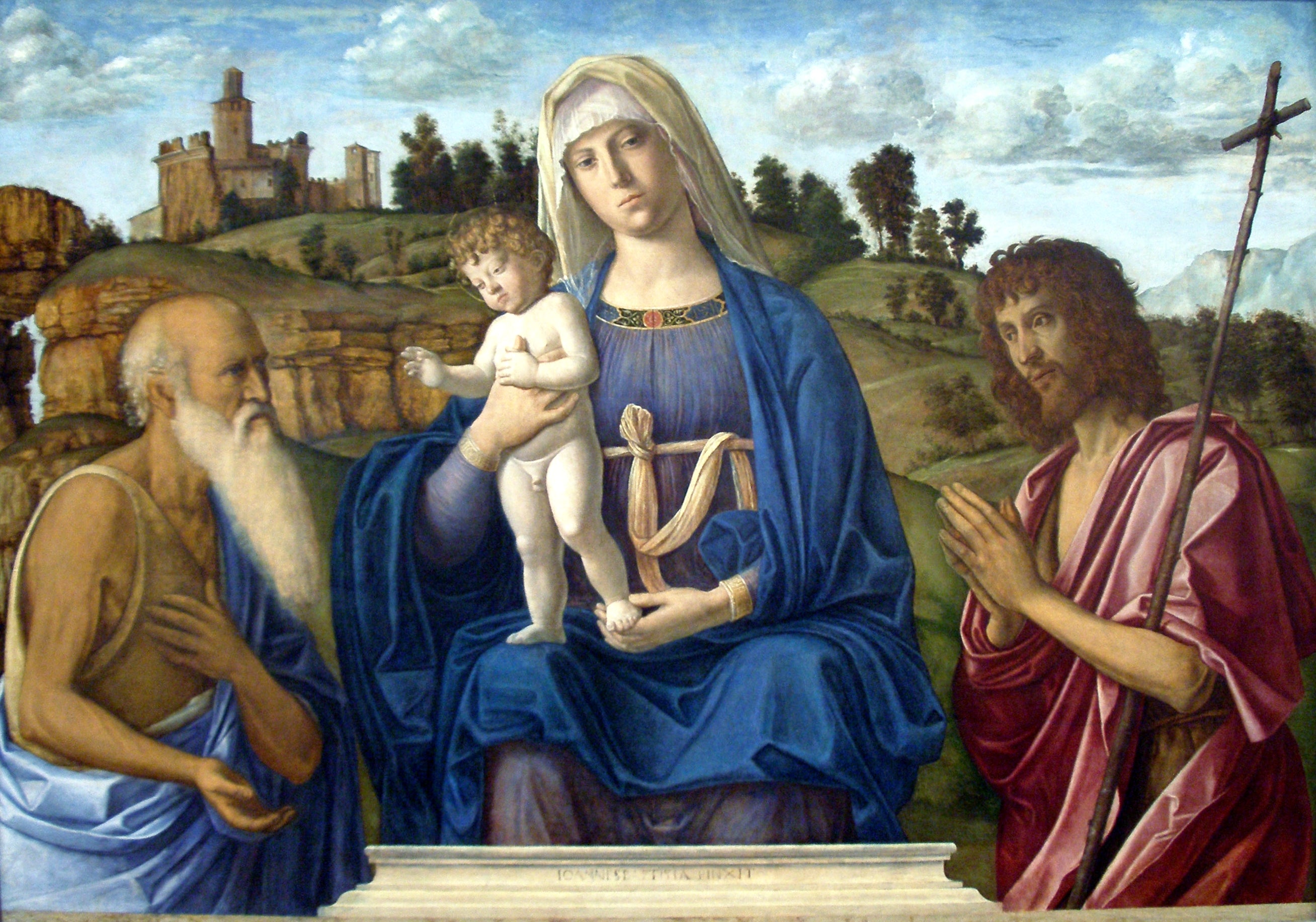
Leave a comment
This site is protected by hCaptcha and the hCaptcha Privacy Policy and Terms of Service apply.